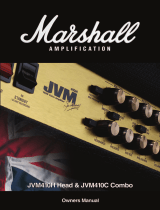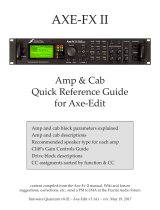7
ENGLISH
ENGLISH
MASTER SECTION
MASTER SECTION Controls (12 - 16) are
common to both AMP 1 and AMP 2.
12. RESONANCE Control
This control operates in the power amp
section of the MODE FOUR and adds a low-
end breadth and ‘thump’ to your sound that
cannot be produced via EQ alone.When used
in conjunction with the BASS control of AMP 1
(5) or AMP 2 (20), the RESONANCE control,
affects the low-end rumble and overall tightness
of your sound. Higher settings will give your
tone a fatter, fuller bottom end.
13. PRESENCE Control
This control also operates in the power amp
section of your amp and adds high frequencies
to your tone, increasing edge and bite. Higher
settings will make your sound become crisper
and more cutting.
14. TUNER MUTE Switch
Engaging the TUNER MUTE switch mutes the
speaker outputs and line outputs of the MODE
FOUR, but allows signal to pass through the
TUNER OUT jack on the rear panel (see page
8) for ‘silent’ tuning.
15. SOLO LEVEL Control
This control allows you to select a volume
boost on all four modes when the BOOST
switch is engaged on the included footcontroller.
The SOLO LEVEL control will, when switched
on, cause a volume increase of up to 6dB (i.e.
twice the volume).
16. MASTER Volume Control
The MASTER Volume control determines the
overall volume of your amplifier. We suggest you
use the AMP 1 and AMP 2 Volume Controls ((6)
and (19), respectively) to set the relative volume
of the two amps and then use the MASTER to
adjust the overall output of your MODE FOUR.
AMP 2 CONTROLS
17. GAIN Control
This GAIN Control is shared by AMP 2’s two
selectable modes, OD1 & OD2.At low gain
settings the valve generated overdrive will be
dynamic and punchy. Increasing the GAIN
Control will make the sound thicker and the
bottom-end more full. At high gain settings the
pre-amp valve is driven into saturation as the
sound becomes more compressed and there is
an increase in the aggressive high end.
18. TONE MATRIX
The three way rotary TONE MATRIX Switch
selects one of three fully independent tone
control networks.
Each of the three positions entirely
reconfigures the tone network for three different
middle frequency responses (see above graph).
This is different than a parametric equalisation
in that the treble and bass controls remain
completely interactive with the middle control.
The three positions give very different pre-
amplifier distortion tones and hence
experimentation is essential.The interactivity
between the three tone controls (BASS,
MIDDLE and TREBLE) cannot be
overemphasised as this relationship varies
between the three positions and again
experimentation will allow you to dial your exact
signature sound as required.
TONE MATRIX Setting 1 – This has the
highest mid frequency value of the three
settings and produces that instantly
recognisable ‘woody knock’ associated with
high-gain Marshall valve amps.
TONE MATRIX Setting 2 – This tightens up
the low-mid frequencies and, as a result, your
tone becomes heavier with less ‘woodiness’.
TONE MATRIX Setting 3 – This is the lowest
of the three settings and is also the most
extreme sounding. It removes the low-mid
frequencies from your sound, giving you an
exaggerated bottom-end that has tremendous
width and ‘thump’.
MODE FOUR Front Panel Features - see panel page 70
19. VOLUME Control
This control determines how loud or quiet
AMP 2 is.This control should be used in
conjunction with AMP 1’s VOLUME control (6)
to set the relative levels of the two amps. Once
this is done you can use the MASTER volume
control (16) to set the overall output level of the
amplifier.
20. BASS Control
This controls the amount of low frequencies
(bottom end) in AMP 2’s tone. Adjusting this
control in conjunction with the RESONANCE
control (12) will drastically affect the size and
tightness of your low end.The more BASS and
RESONANCE you dial in, the fatter your
bottom will become.
TONE TIP: Due to the unique nature of AMP
2’s design, the low end becomes even bigger
and also has an incredible ‘thump’ at high
volumes – especially when TONE MATRIX
Setting 3 is selected. Adjust BASS (20) and
RESONANCE (12) according to taste.
21. REVERB Control
This controls the level of the MODE FOUR’s
specially designed, built-in, digital Reverb for
AMP 2.
22. MIDDLE Control
This control adjusts the level of the all-
important mid-range in your sound once
AMP 2’s mid-frequency has been selected with
the TONE MATRIX switch (18).Turning this
control up will make your guitar sound fatter
and fuller. Conversely, turning it down will
reduce the mids in your sound, giving you an
aggressive ‘scooped’tone.
23. SCOOP Switch
This control is voiced differently to the
SCOOP switch on AMP 1 and has been
meticulously fine-tuned to work with the sonic
characteristics of AMP 2, reconfiguring the
entire post-EQ voicing to give you the most
uncompromising and brutal ‘scoop’ sound.
24. FX LEVEL Control
This controls the amount of external effect
that is mixed in with the dry (uneffected) signal
of AMP 2. Please refer to the FX Loop section
(page 8) for further details.
25. TREBLE Control
This controls the amount of treble and makes
your guitar’s tone brighter as it is turned up.
TONE TIP: As is the case with AMP 1,
AMP 2’s tone network is highly interactive and
because of this, altering one control can have a
significant impact on your overall sound. As
always, experimentation is the best way to
achieve the tone(s) you desire.
26. OD1 Mode Select Switch
Push this switch to select the OD1 mode of
AMP 2.When this mode is selected via the
front panel or the supplied 6-way footcontroller,
the LED within this switch will light up.
OD1 produces a modern, high gain tone with
a slightly accentuated treble response and a
large, tight bottom-end.
27. OD2 Mode Select Switch
Pushing this switch selects the OD2 mode of
AMP 2.When this mode is selected via the
front panel or the supplied 6-way footcontroller,
the LED within this switch lights up.
OD2 produces a staggering amount of gain
and also boasts an incredibly full and wide low-
end thump – especially when TONE MATRIX
Setting 3 is selected and the MODE FOUR is
at high volume.
28. POWER Switch
This is the On/Off switch for the mains power
to the amplifier. When it is switched ‘On’, the
switch will light. Please ensure the amplifier is
switched off and unplugged from the mains
electricity supply before being moved.
IMPORTANT NOTE: As is the case with an
all-valve amplifier, there will be no signal heard
until the amp's ECC83 pre-amp valves warm-
up and start to pass signal. This can take up to
30 seconds so don't panic!
















